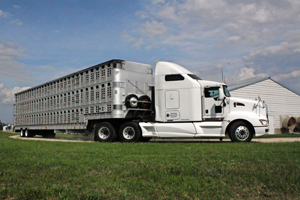Causes, effects of pig stress during transportation

Stress imposed on pigs during transport is both an animal welfare and a meat quality issue. It can be so high and result in animal losses due to death, injuries or fatigue and ultimately poor pork quality.
Animal losses, currently defined as dead and non-ambulatory pigs, are most commonly observed during unloading at the packing plant, but can occur at any stage of the marketing process from loading at the farm to stunning at the plant. Death losses are usually defined as ‘dead on arrival’ (DOA), meaning a pig that died during transportation, while a nonambulatory pig is a pig unable to move or keep up with the rest of the group at the plant. There are two types of non-ambulatory pigs observed under commercial conditions:
Injured pigs have a compromised ability to move due to structural unsoundness or due to an injury sustained during the marketing process. Meanwhile, fatigued pigs are pigs without obvious injury, trauma, or disease that refuse to walk at any stage of the marketing process from loading at the farm to stunning at the plant. The majority of non-ambulatory pigs at the plant are classified as fatigued and the frequency of observations of the two pig types on arrival at the plant is seven fatigued pigs to one injured pig. Fatigued pigs display signs of acute stress (open-mouth breathing, skin discolouration, and/ or muscle tremors), are in a metabolic state of acidosis, and may have elevated body temperatures. However, controlled research has demonstrated that the vast majority of fatigued pigs can metabolically recover, if the stressors are removed, and pigs are allowed to rest for two to three hours. A recent review of field trials conducted in the United States between 2000 and 2007 reported that of all pigs marketed, 0.25% died during transport and an additional 0.44% were nonambulatory on arrival at the plant. In Canada, up to 0.08% DOA and 0.25% non ambulatory pigs have been reported. A pig death during transit is a major economic loss for producers and transporters. With approximately 109 million pigs being slaughtered annually in the United States, the proportion of DOA (0.17%) cost pork producers more than $3 million in 2010.
Effect of the farm
An epidemiological study in Canada reporting 0.17% in-transit mortality rate and 0.27% non-ambulatory pigs on arrival at the plant identified the major source of animal losses variation as being the farm (25%) followed by the transporter and the packer (16% each). The effect of the farm of origin on animal losses and stress response as well as on carcass and meat quality in pigs can be partly attributed to differences in the preparation of pigs for transport (i.e. feed withdrawal), barn design and in the handling of pigs as they are moved out of the barn and loaded onto the truck.
Feed withdrawal
Feed withdrawal is one of the practices for on-farm preparation of pigs before harvest which in Canada is regulated by codes of practice. The potential advantages of feed withdrawal include the higher well-being of animals during transport, resulting in lower proportion of animal losses, higher ease of handling, reduced carcass contamination due to lower risk of gut contents spillage during carcass evisceration, and improved pork quality. Despite these potential advantages, however, feed withdrawal is sometimes not used or misapplied by producers, resulting in complaints and penalties from the slaughter sector. Some reasons for not withholding feed prior to transport are: Lack of a shipping room to which pigs sorted by live weight (split-marketing) could be transferred from their home pen in order to withdraw feed and allow them to rest until the arrival of the truck; and Concern about body weight losses reducing the economic value of the carcass. However, significant carcass weight losses have only been reported after 24 hours of feed withdrawal, in terms of 100 g weight loss for every additional hour. This loss results in a 0.33-point difference in dressing yield, which is equivalent to 30 g/h of cold carcass weight loss for a pig weighing 110 kg at slaughter. The application of 24 hour feed withdrawal also permits a saving of 2 kg of feed/ pig. Based on current data, a period of 24 hour between the last meal and slaughter appears to be an acceptable compromise to obtain optimal carcass yield and pork quality and safety.
Loading facilities and handling
Loading pigs onto the truck is considered the most critical stage of the transport period as showed by the 110- 130 increase in the heart rate and by the increase of stress indicators (lactate) levels in blood compared to the values observed for a pig at rest, with these effects lasting until slaughter and eventually affecting meat quality. The stress associated with the loading procedure results from a combination of different factors, such as the design of the loading facility (either ramp or quay), group size and handling system.
Alley and ramp design
On farms, the alley width is generally limited to the width of two pigs (0.6 to 0.8 m). However, these recommendations
may not be applicable to the pigs of today as they are larger than in the past, which may result in increased incidence of bruises and lacerations on the carcass caused by animals hitting the alley and ramp walls while being driven to the truck. In view of the risk of injury and the changes in pig body weight (from 113 to 130 kg) and conformation (8-10 cm wider) that have occurred over the last five years, the barn ramp and exit width have been increased by almost 1 m at a number of Canadian swine farms.
Group size
Moving pigs in a group size larger than the farm alley, loading quay or ramp is a common practice at loading. This practice is mistakenly considered effective for speeding up handling; instead, it increases aggression and reduces resting behaviour, even in unmixed pigs. Considering the heart rate increase and the time involved in loading a transport vehicle, moving groups of two to six pigs at a time, depending on the farm alley and loading quay or ramp design, is recommended to help both producers and transporters save costs and ensure good animal welfare.
Moving tools
Poor farm facilities combined with the presence of large groups of pigs may cause handling problems at loading leading to indiscriminate use of electrical prodding and slowing down the loading procedure. Based on the lower number of pigs slipping, falling and overlapping during loading, the lower proportion of fatigued pigs (0 vs 2.5%) and better pork quality, the paddle has been proposed as a viable alternative to the use of the electric prod for driving pigs out of the finishing pen and along the alley and loading ramp. However, it is noteworthy that aggressive handling from handlers is often related to their fatigue caused by the physical effort (as showed by higher heart rate) to load pigs onto a truck, especially when facilities are inadequate (too steep ramp slope; Figure 1) or multiple shipments are made during the day.
Transport conditions
Trailer design
In Canada, truck designs can vary widely, from small single deck trucks to large three-deck punch-hole trailers (often referred to as ‘pot-belly’ trailers; Figure 2). Pot-belly (PB) trailers are quite common in Canada, as they are often dual-purpose (transporting either pigs or cattle) and allow to transport large loads of pigs (more than 200) on three decks (ten compartments) in one journey and for long distances. However, these vehicles incorporate multiple (up to five) and steep (up to 40° slope) internal ramps and 180° turns, which result in a lower easiness of handling during loading and unloading, increasing the use of electric prods and extending the load and unload time. These observations have been associated with the higher proportion of DOA and fatigued pigs in the PB trailer when compared to other vehicle types equipped with hydraulic decks. This difference in stress response (based on exsanguination blood variables) between the PB trailer and other vehicle types equipped with hydraulic decks (flat-deck trailer) is even more evident when it is used to haul stresssusceptible (Hal-carriers) genotypes for a short distance (40 km). It has been evidenced that the animal location (deck and/ or compartment position in the truck) during transportation has an impact on its welfare and meat quality. Within the PB trailer, a higher proportion (32%) of pale pork was reported in pigs transported in the upper and lower decks in summer. Within the deck, pigs located in the upper front and bottom rear compartments showed an increased body temperature after loading and higher heart rate at unloading, while higher pHu and lower drip loss values, indicative of dark, firm, dry (DFD) pork, were reported in the loin and hams of pigs located in the middle front compartment (‘bottom-nose’).
Microclimate control
Environmental temperature during transit is generally considered as one of the greatest contributors to in-transit losses. The highest deaths recorded in the above-mentioned Canadian epidemiological study were during the month of August (0.40%) when the maximum ambient temperature was 33.6°C. However, greater animal losses have been also reported in winter and at ambient temperatures ≤5°C. Temperatures up to approximately 30.2°C have been reported inside the PB trailer, with the lower front compartments being up to 10°C warmer than the external ambient temperature during Canadian commercial transports. Recent Canadian research showed starting from an internal temperature of 26.3˚C, DOA can increase by 1.26 for every additional internal temperature increase of 1˚C. The higher temperatures have been explained by the poor air flow (ventilation) inside the truck, especially when it is stationary. To improve pig thermal comfort in the summer, stationary PB trailers should be cooled by increasing the ventilation rate using fans in combination or not with water sprinkling to increase evaporative cooling. A recent study reported that the application of water sprinkling after loading and before unloading starting from 20°C ambient temperature reduced the body temperature upon arrival at the plant, drinking behaviour at the plant and acidosis, all resulting in better pork quality, especially in pigs located in the middle front compartment.
Duration and distance
With the consolidation of the slaughter industry, more pigs are being killed in fewer but larger slaughterhouses, leading to an increase in transport distances and durations. A short journey duration may have a negative influence on welfare, meat quality and in extreme cases on the mortality rate of market pigs. It has been reported that for each 50 km increase in distance, DOA can be expected to decrease 0.81 times. Similarly, it has been observed that pigs hauled very short distances for under 30 minutes are less easy-to-handle at the plant and may produce pale and exudative pork than pigs transported for longer distances. However, it appears that transport longer than six hours, especially in winter, may result in muscle energy depletion and an increased incidence of meat quality defects related to the production of dark pork.
Source: Pig Progress magazine Volume 29.6 (2013)











